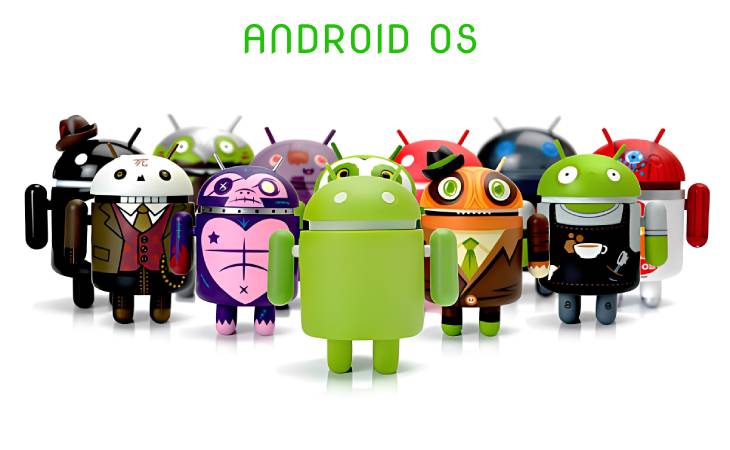Table of Contents
Introduction
Android, designed primarily for touchscreen mobile devices like smartphones and tablets, is a mobile operating system (OS) built on a customized version of the Linux kernel and other open-source software.
Furthermore, it is developed by a group of developers recognized as the Open Handset Alliance, though Google primarily develops its most commonly used version.
History of Android OS:
The history of the Android operating system is marked by significant milestones, from its commencement to becoming the world’s most widely used mobile platform. Here’s a synopsis of the events in the evolution of Android:
- Early Development (2003-2007): Android was founded by Andy Rubin, Rich Miner, Nick Sears, and Chris White in October 2003. Subsequently, in 2005, Google took possession of Android Inc., and Andy Rubin continued to lead the project.
- Open Handset Alliance (2007): On November 5, 2007, the Open Handset Alliance (OHA) was proclaimed, consisting of several major hardware, software, and telecom companies.
- Android 1.0 (2008): Android 1.0 was released on September 23, 2008. It laid the foundation for the Android ecosystem with indispensable features like notifications, widgets, and the integration of Google services.
- Version Updates (2009-2010): Prominent releases during this period comprised Cupcake (1.5), Donut (1.6), Éclair (2.0-2.1), and Froyo (2.2). Furthermore, these releases introduced advancements, including features like voice-activated search, enhanced performance, and compatibility with higher screen resolutions.
- Growth and Market Dominance (2011-2013): Vital releases during this period included Gingerbread (2.3), Ice Cream Sandwich (4.0), Jelly Bean (4.1-4.3), and KitKat (4.4).
- Material Design and Lollipop (2014): Android 5.0 Lollipop, released in 2014, announced the Material Design language, stressing a more consistent and visually interesting user interface across devices.
- Marshmallow to Oreo (2015-2017): Versions 6.0 (Marshmallow) to 8.0 (Oreo) continued to augment the Android experience with features like runtime permissions, improved battery life management, and picture-in-picture mode.
- Android Pie and Android 10 (2018): Android 9.0 Pie presented gestures for navigation and underscored digital well-being features to promote a healthy balance between technology use and personal life. Consequently, Android 10, released in 2019, carried a system-wide dark mode, privacy controls, and gesture navigation improvements.
- Android 11 and Android 12 (2020-2021): Android 11 prioritized conversation management, upgraded media controls, and strengthened privacy settings. Meanwhile, the 2021 release of Android 12 brought forth Material You, a redesigned user interface.
- Ongoing Evolution (2022 and Beyond): Android endures to progress with regular updates, introducing new features, security enhancements, and support for emerging technologies.
Features of Android OS:
- Open-source: Being open-source, Android allows for modification and distribution by any entity. Hence, this has resulted in a diverse range of custom Android ROMs and devices.
- Customization: It is highly customizable, allowing users to change the look and feel of their devices to suit their preferences better.
- App ecosystem: The operating system has a massive and vibrant app ecosystem, with millions of apps available in the Google Play Store.
- Google integration: Android is profoundly integrated with Google services, such as Gmail, Maps, and Drive.
- Security Features: The open-source incorporates numerous security features, such as app sandboxing, permission system, and verified boot. In addition, Google Play Protect, a built-in security feature, scans apps for potential threats and keeps the device secure.
- Google Assistant: It integrates Google Assistant, which is a virtual assistant allowing users to interact with their devices using voice commands.
- Accessibility Features: The operating system incorporates various accessibility features, guaranteeing effective usability for individuals with disabilities. In addition, these features include functions like screen readers, magnification gestures, and voice commands.
- Affordability: Android devices span diverse price points, rendering them a better cost-effective option than numerous other mobile operating systems.
Categories of Android OS Applications:
Android applications span various categories, catering to diverse user needs and interests. Here are some common categories of Android applications:
- Social Networking
- Communication
- Entertainment
- Productivity
- Utilities
- Travel and Navigation
- News and Magazine
- Gaming
- Health and Fitness
- Shopping
- Finance
- Photography
- Lifestyle
- Weather
- Education and much more.
What are the Versions of Android OS?
- Android 1.5 Cupcake (April 27, 2009)
- Android 1.6 Donut (Spt. 15, 2009)
- Android 2.0 and 2.1 Éclair (Oct. 26, 2009)
- Android 2.2 Froyo (May 20, 2010)
- Android 2.3 Gingerbread (Dec. 06, 2010)
- Android 3.0, 3.1, and 3.2 Honeycomb (Feb. 22, 2011)
- Android 4.0 known as Ice Cream Sandwich (October 18, 2011)
- Android 4.1, 4.2, and 4.3 Jelly Bean (July 09, 2012)
- Android 4.4 KitKat (Oct. 31, 2013)
- Android 5.0 and 5.1 Lollipop (Nov. 12, 2014)
- Android 6.0 Marshmallow (Oct. 05, 2015)
- Android 7.0 and 7.1 Nougat (Aug. 22, 2016)
- Android 8.0 and 8.1 Oreo (Aug. 21, 2017)
- Android 9 Pie (Aug. 06, 2018)
- Android 10 Q (Sep. 03, 2019)
- Android 11 Red Velvet Cake (Sep. 08, 2020)
- Android 12 Snow Cone (Oct. 04, 2021)
- Android 12L (Mar. 07, 2022)
- Android 13 Tiramisu (Aug. 15, 2022)
- Android 14 Upside Down Cake (Oct. 04, 2023)
Conclusion:
In conclusion, the Android operating system has progressed into a versatile and broadly adopted platform since its commencement. Moreover, its open-source nature, diverse application ecosystem, and customization choices have contributed to its popularity across various devices.
The platform continues to familiarize itself with the varying technological landscape with continual updates, security enhancements, and new features. Additionally, the system’s integration with Google services, support for numerous form factors, and commitment to accessibility solidify its position as a leading mobile operating system.
While facing challenges such as fragmentation, Android remains a dynamic and innovative OS, influencing the digital experiences of millions of users globally.

